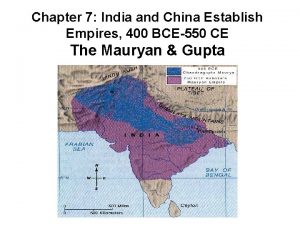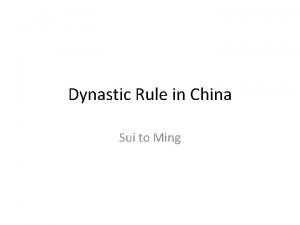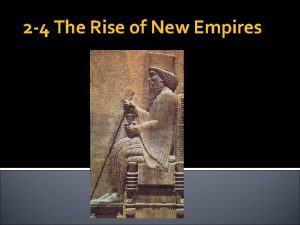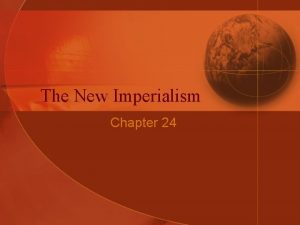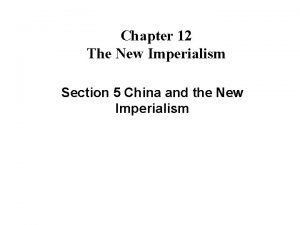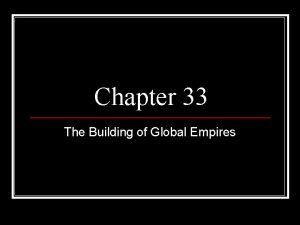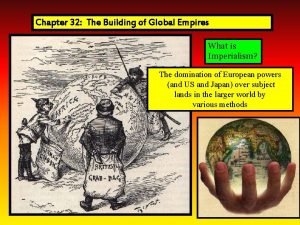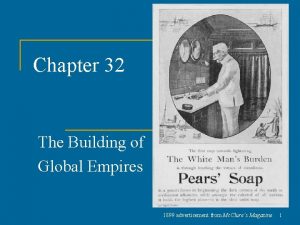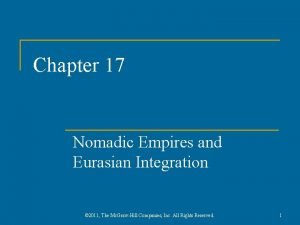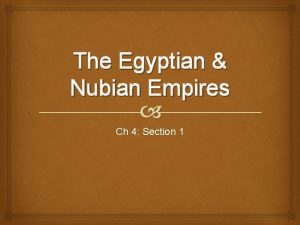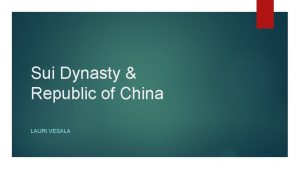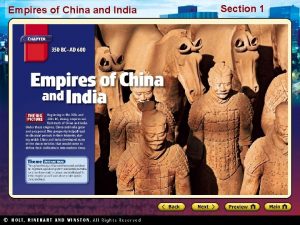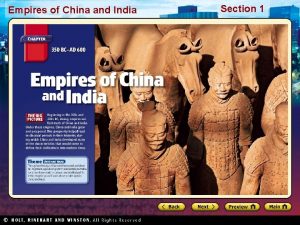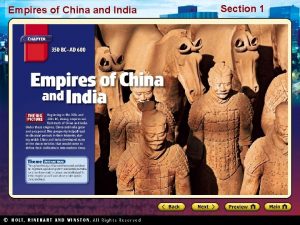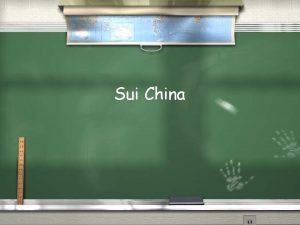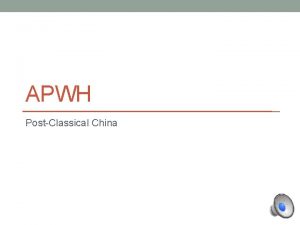New Empires in China Chapter 14 Notes Sui















- Slides: 15

New Empires in China Chapter 14 Notes

Sui Dynasty 589 -618 CE • Similar to Qin (Shihuangdi) in tactics – Strict discipline of subjects – Extremely centralized government – Much construction of palaces – Rebuilt and improved defensive walls – High taxes – Forced labor – Military expansion

Sui Dynasty 589 -618 CE • Built the Grand Canal – Connected North and South China for trade – Rivers run West to East, so canal was the only way to transport large amounts of goods north and south – Used heavily for over 1000 years…finally replaced with railroads in 1800 s. – High taxes and forced labor led to hostility – Emperor assassinated in 618…ended Sui Dynasty

The Grand Canal • l

Tang Dynasty 618 -907 CE • Tang Taizong – first Tang emperor – Ambitious/ruthless is gaining throne, but ultimately good leader – Confucian principles – Low taxes – Stability and prosperity

Tang Dynasty 618 -907 CE • Transportation and Communications – Roads, horses, human runners – Entire empire could be reached within 8 days – Inns, stables, restaurants, provided for travelers and messengers

Tang Dynasty 618 -907 CE • Equal-Field System – Equitable distribution of land (land = wealth) – Land allotted according to fertility and need – Only 1/5 of property retained in heredity – Over time, system began to fail

Tang Dynasty 618 -907 CE • Bureaucracy based on MERIT – Confucianism! – Civil service exams – Education – Possibility of advancement, prosperity for everyone

Tang Dynasty 618 -907 CE • Foreign relations: – Sent military into Manchuria, Korea, Northern Vietnam, Central Asia (-stan countries), plateau of Tibet – Other lands became subject to China…owed gifts and respect…envoys performed the “kowtow” – Subject lands were given more in return, and mostly left alone. – Seen as the duty of China to look out for neighbors – Formalized close connections between China and other East Asian nations

Tang Dynasty 618 -907 CE

Tang Dynasty 618 -907 CE • Later emperors were not as strong • Rebellions weakened dynasty • Equal field system deteriorated, taxes went down…military could not resist outsiders • Uighurs (nomadic Turks from Central Asia) invited in…weakened empire further • Dynasty ended in 907 with abdication of last Tang emperor.

Side Note – Uighurs (or Uyghurs) • Part of China today • Muslim

Song Dynasty 960 -1279 CE • Period after Tang marked by decentralized control of warlords • Never as strong as Tang • Still kept Confucian principles of education and civil service • Bureaucracy kept growing…salaries depleted the treasure • Scholars/bureaucrats appointed to oversee military…no practical expertise

Song Dynasty 960 -1279 CE • Military lost northern territory…Latter part of Song Dynasty called “Southern Song, ” as only the southern half of the original land stayed intact. • Resurgence of Silk Road trading • Agricultural and technological advancements led to population growth and urbanization – Rice varieties increased food supply – Iron plow – Irrigation systems

Changes during Tang and Song • Foot binding • Better technology…more trades – Porcelain – Gun-powder – Iron and steel weaponry – Block printing – Compass – Banking advancements…checks, credit, paper money – Buddhism
 How were maritime and land based empires similar
How were maritime and land based empires similar Chapter 7 india and china establish empires
Chapter 7 india and china establish empires How was china reunited under the sui dynasty?
How was china reunited under the sui dynasty? How did the sui dynasty affect daily life in china
How did the sui dynasty affect daily life in china How did the sui and tang dynasties reunite china
How did the sui and tang dynasties reunite china The rise of new empires
The rise of new empires Chapter 24 section 5 china and the new imperialism
Chapter 24 section 5 china and the new imperialism Chapter 12 section 5 china and the new imperialism
Chapter 12 section 5 china and the new imperialism Chapter 33 the building of global empires
Chapter 33 the building of global empires Chapter 32 the building of global empires
Chapter 32 the building of global empires Chapter 32 the building of global empires
Chapter 32 the building of global empires Chapter 17 nomadic empires and eurasian integration
Chapter 17 nomadic empires and eurasian integration Chapter 17 nomadic empires and eurasian integration
Chapter 17 nomadic empires and eurasian integration Chapter 19 islamic gunpowder empires
Chapter 19 islamic gunpowder empires Chapter 4 section 1 the egyptian and nubian empires
Chapter 4 section 1 the egyptian and nubian empires Chapter 5 political transformations empires and encounters
Chapter 5 political transformations empires and encounters

